Financial Management: Investment Appraisal Report for M&R PLC
VerifiedAdded on 2023/06/15
|11
|2225
|373
Report
AI Summary
This report provides a comprehensive analysis of investment options for M&R PLC, utilizing capital budgeting techniques such as Net Present Value (NPV) and Profitability Index (PI). The first part evaluates two investment options, considering the impact of inflation and comparing nominal and real approaches to investment assessment. It includes calculations of NPV and PI for three projects, recommending the most viable investment based on these metrics. The second part consists of true/false and multiple-choice questions related to capital budgeting principles. The report concludes by emphasizing the importance of sound investment decisions and the effective use of capital budgeting tools for enhancing profitability and managing risk, highlighting how organizations can improve their financial performance through strategic investment choices.

Running Head: FINANCIAL MANAGEMENT
FINANCIAL MANAGEMENT
FINANCIAL MANAGEMENT
Paraphrase This Document
Need a fresh take? Get an instant paraphrase of this document with our AI Paraphraser
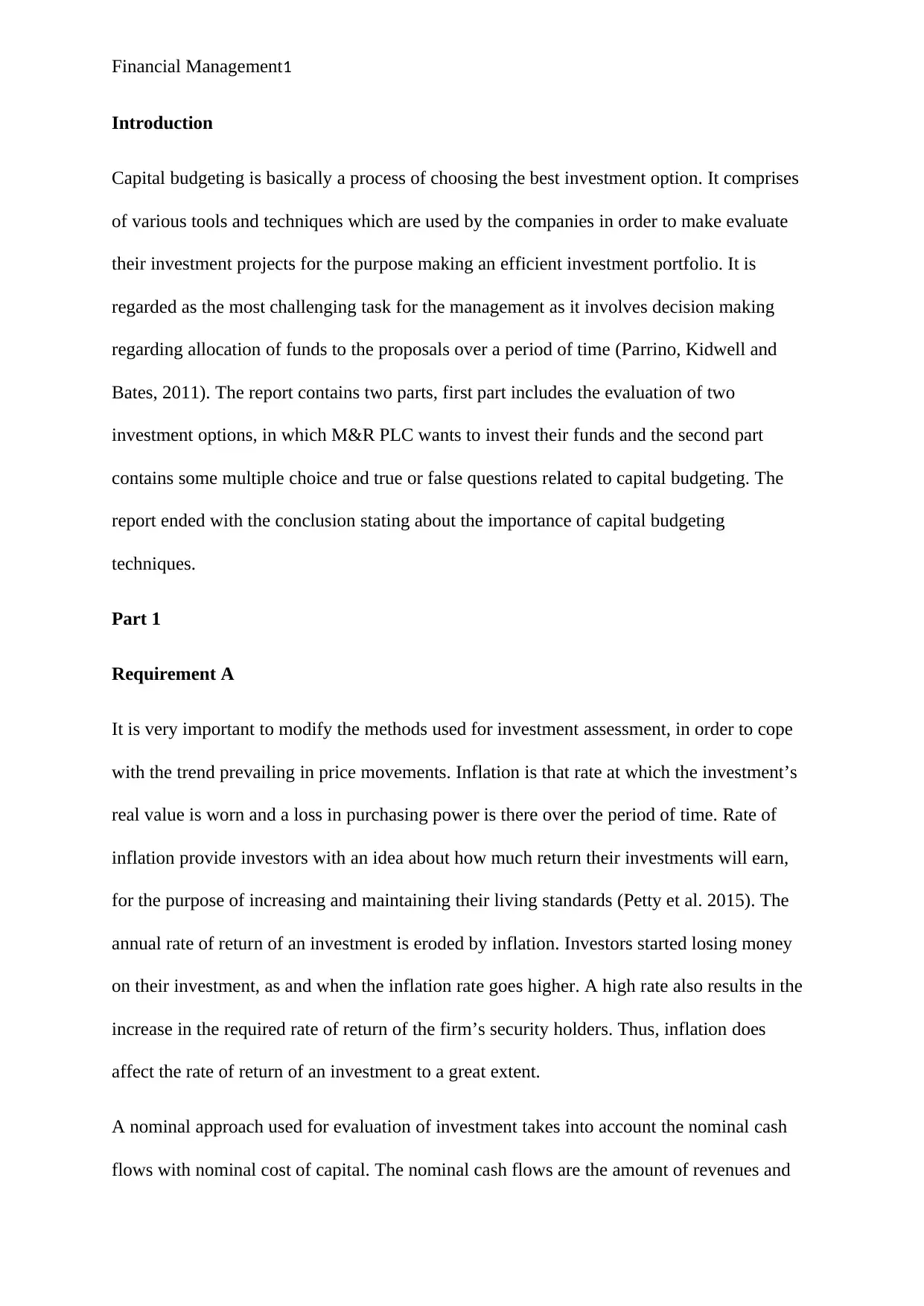
Financial Management1
Introduction
Capital budgeting is basically a process of choosing the best investment option. It comprises
of various tools and techniques which are used by the companies in order to make evaluate
their investment projects for the purpose making an efficient investment portfolio. It is
regarded as the most challenging task for the management as it involves decision making
regarding allocation of funds to the proposals over a period of time (Parrino, Kidwell and
Bates, 2011). The report contains two parts, first part includes the evaluation of two
investment options, in which M&R PLC wants to invest their funds and the second part
contains some multiple choice and true or false questions related to capital budgeting. The
report ended with the conclusion stating about the importance of capital budgeting
techniques.
Part 1
Requirement A
It is very important to modify the methods used for investment assessment, in order to cope
with the trend prevailing in price movements. Inflation is that rate at which the investment’s
real value is worn and a loss in purchasing power is there over the period of time. Rate of
inflation provide investors with an idea about how much return their investments will earn,
for the purpose of increasing and maintaining their living standards (Petty et al. 2015). The
annual rate of return of an investment is eroded by inflation. Investors started losing money
on their investment, as and when the inflation rate goes higher. A high rate also results in the
increase in the required rate of return of the firm’s security holders. Thus, inflation does
affect the rate of return of an investment to a great extent.
A nominal approach used for evaluation of investment takes into account the nominal cash
flows with nominal cost of capital. The nominal cash flows are the amount of revenues and
Introduction
Capital budgeting is basically a process of choosing the best investment option. It comprises
of various tools and techniques which are used by the companies in order to make evaluate
their investment projects for the purpose making an efficient investment portfolio. It is
regarded as the most challenging task for the management as it involves decision making
regarding allocation of funds to the proposals over a period of time (Parrino, Kidwell and
Bates, 2011). The report contains two parts, first part includes the evaluation of two
investment options, in which M&R PLC wants to invest their funds and the second part
contains some multiple choice and true or false questions related to capital budgeting. The
report ended with the conclusion stating about the importance of capital budgeting
techniques.
Part 1
Requirement A
It is very important to modify the methods used for investment assessment, in order to cope
with the trend prevailing in price movements. Inflation is that rate at which the investment’s
real value is worn and a loss in purchasing power is there over the period of time. Rate of
inflation provide investors with an idea about how much return their investments will earn,
for the purpose of increasing and maintaining their living standards (Petty et al. 2015). The
annual rate of return of an investment is eroded by inflation. Investors started losing money
on their investment, as and when the inflation rate goes higher. A high rate also results in the
increase in the required rate of return of the firm’s security holders. Thus, inflation does
affect the rate of return of an investment to a great extent.
A nominal approach used for evaluation of investment takes into account the nominal cash
flows with nominal cost of capital. The nominal cash flows are the amount of revenues and
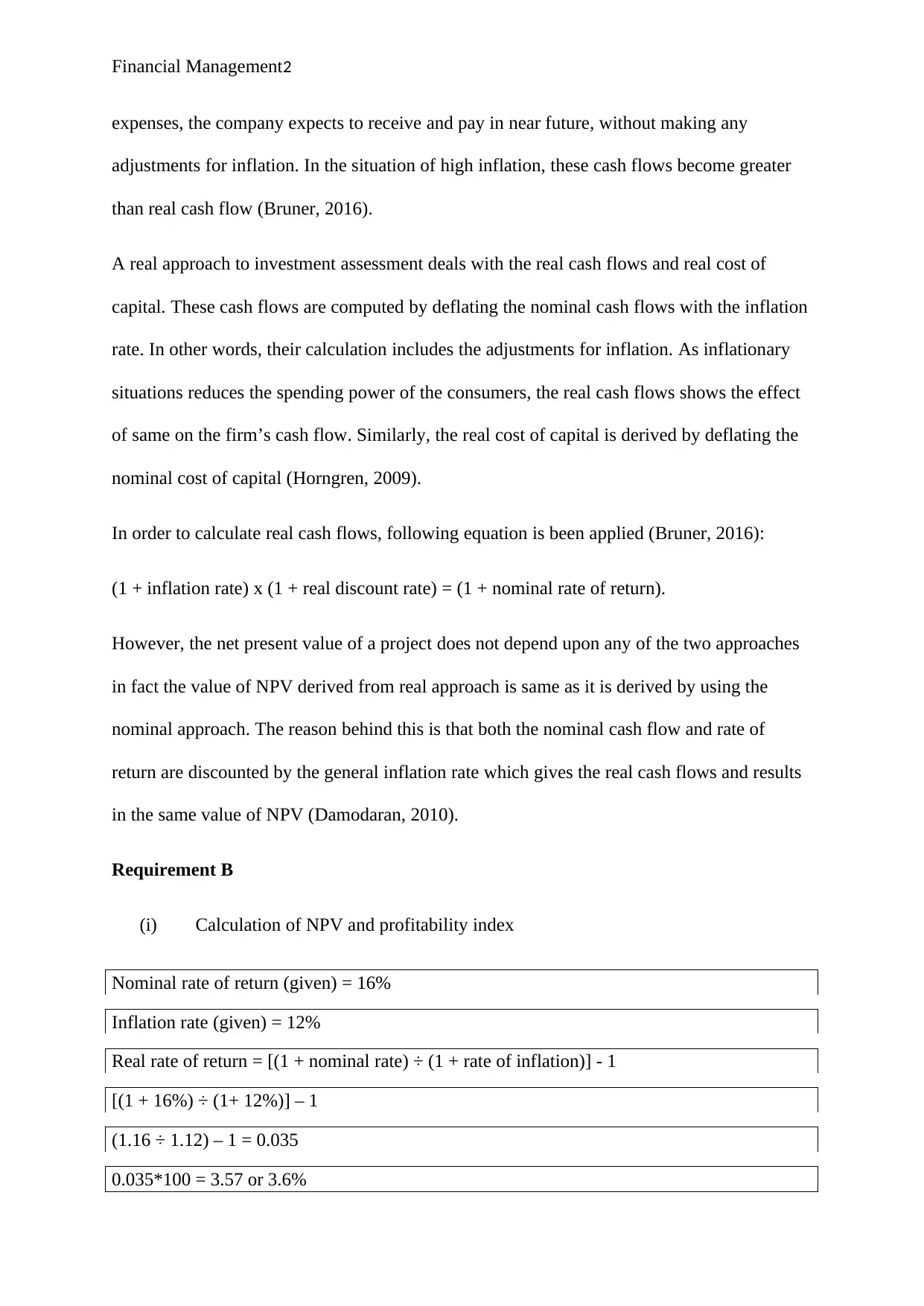
Financial Management2
expenses, the company expects to receive and pay in near future, without making any
adjustments for inflation. In the situation of high inflation, these cash flows become greater
than real cash flow (Bruner, 2016).
A real approach to investment assessment deals with the real cash flows and real cost of
capital. These cash flows are computed by deflating the nominal cash flows with the inflation
rate. In other words, their calculation includes the adjustments for inflation. As inflationary
situations reduces the spending power of the consumers, the real cash flows shows the effect
of same on the firm’s cash flow. Similarly, the real cost of capital is derived by deflating the
nominal cost of capital (Horngren, 2009).
In order to calculate real cash flows, following equation is been applied (Bruner, 2016):
(1 + inflation rate) x (1 + real discount rate) = (1 + nominal rate of return).
However, the net present value of a project does not depend upon any of the two approaches
in fact the value of NPV derived from real approach is same as it is derived by using the
nominal approach. The reason behind this is that both the nominal cash flow and rate of
return are discounted by the general inflation rate which gives the real cash flows and results
in the same value of NPV (Damodaran, 2010).
Requirement B
(i) Calculation of NPV and profitability index
Nominal rate of return (given) = 16%
Inflation rate (given) = 12%
Real rate of return = [(1 + nominal rate) ÷ (1 + rate of inflation)] - 1
[(1 + 16%) ÷ (1+ 12%)] – 1
(1.16 ÷ 1.12) – 1 = 0.035
0.035*100 = 3.57 or 3.6%
expenses, the company expects to receive and pay in near future, without making any
adjustments for inflation. In the situation of high inflation, these cash flows become greater
than real cash flow (Bruner, 2016).
A real approach to investment assessment deals with the real cash flows and real cost of
capital. These cash flows are computed by deflating the nominal cash flows with the inflation
rate. In other words, their calculation includes the adjustments for inflation. As inflationary
situations reduces the spending power of the consumers, the real cash flows shows the effect
of same on the firm’s cash flow. Similarly, the real cost of capital is derived by deflating the
nominal cost of capital (Horngren, 2009).
In order to calculate real cash flows, following equation is been applied (Bruner, 2016):
(1 + inflation rate) x (1 + real discount rate) = (1 + nominal rate of return).
However, the net present value of a project does not depend upon any of the two approaches
in fact the value of NPV derived from real approach is same as it is derived by using the
nominal approach. The reason behind this is that both the nominal cash flow and rate of
return are discounted by the general inflation rate which gives the real cash flows and results
in the same value of NPV (Damodaran, 2010).
Requirement B
(i) Calculation of NPV and profitability index
Nominal rate of return (given) = 16%
Inflation rate (given) = 12%
Real rate of return = [(1 + nominal rate) ÷ (1 + rate of inflation)] - 1
[(1 + 16%) ÷ (1+ 12%)] – 1
(1.16 ÷ 1.12) – 1 = 0.035
0.035*100 = 3.57 or 3.6%
⊘ This is a preview!⊘
Do you want full access?
Subscribe today to unlock all pages.

Trusted by 1+ million students worldwide
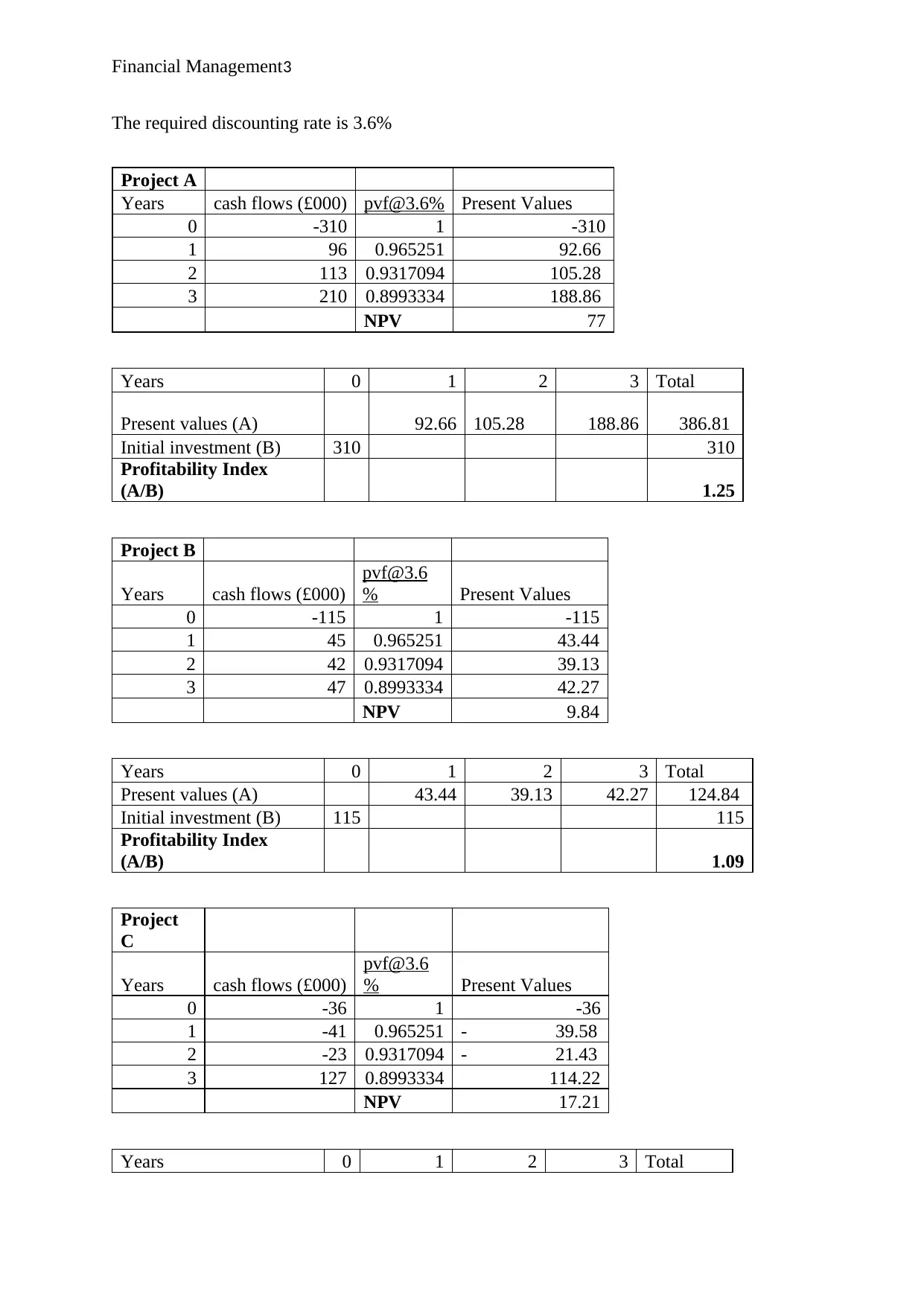
Financial Management3
The required discounting rate is 3.6%
Project A
Years cash flows (£000) pvf@3.6% Present Values
0 -310 1 -310
1 96 0.965251 92.66
2 113 0.9317094 105.28
3 210 0.8993334 188.86
NPV 77
Years 0 1 2 3 Total
Present values (A) 92.66 105.28 188.86 386.81
Initial investment (B) 310 310
Profitability Index
(A/B) 1.25
Project B
Years cash flows (£000)
pvf@3.6
% Present Values
0 -115 1 -115
1 45 0.965251 43.44
2 42 0.9317094 39.13
3 47 0.8993334 42.27
NPV 9.84
Years 0 1 2 3 Total
Present values (A) 43.44 39.13 42.27 124.84
Initial investment (B) 115 115
Profitability Index
(A/B) 1.09
Project
C
Years cash flows (£000)
pvf@3.6
% Present Values
0 -36 1 -36
1 -41 0.965251 - 39.58
2 -23 0.9317094 - 21.43
3 127 0.8993334 114.22
NPV 17.21
Years 0 1 2 3 Total
The required discounting rate is 3.6%
Project A
Years cash flows (£000) pvf@3.6% Present Values
0 -310 1 -310
1 96 0.965251 92.66
2 113 0.9317094 105.28
3 210 0.8993334 188.86
NPV 77
Years 0 1 2 3 Total
Present values (A) 92.66 105.28 188.86 386.81
Initial investment (B) 310 310
Profitability Index
(A/B) 1.25
Project B
Years cash flows (£000)
pvf@3.6
% Present Values
0 -115 1 -115
1 45 0.965251 43.44
2 42 0.9317094 39.13
3 47 0.8993334 42.27
NPV 9.84
Years 0 1 2 3 Total
Present values (A) 43.44 39.13 42.27 124.84
Initial investment (B) 115 115
Profitability Index
(A/B) 1.09
Project
C
Years cash flows (£000)
pvf@3.6
% Present Values
0 -36 1 -36
1 -41 0.965251 - 39.58
2 -23 0.9317094 - 21.43
3 127 0.8993334 114.22
NPV 17.21
Years 0 1 2 3 Total
Paraphrase This Document
Need a fresh take? Get an instant paraphrase of this document with our AI Paraphraser
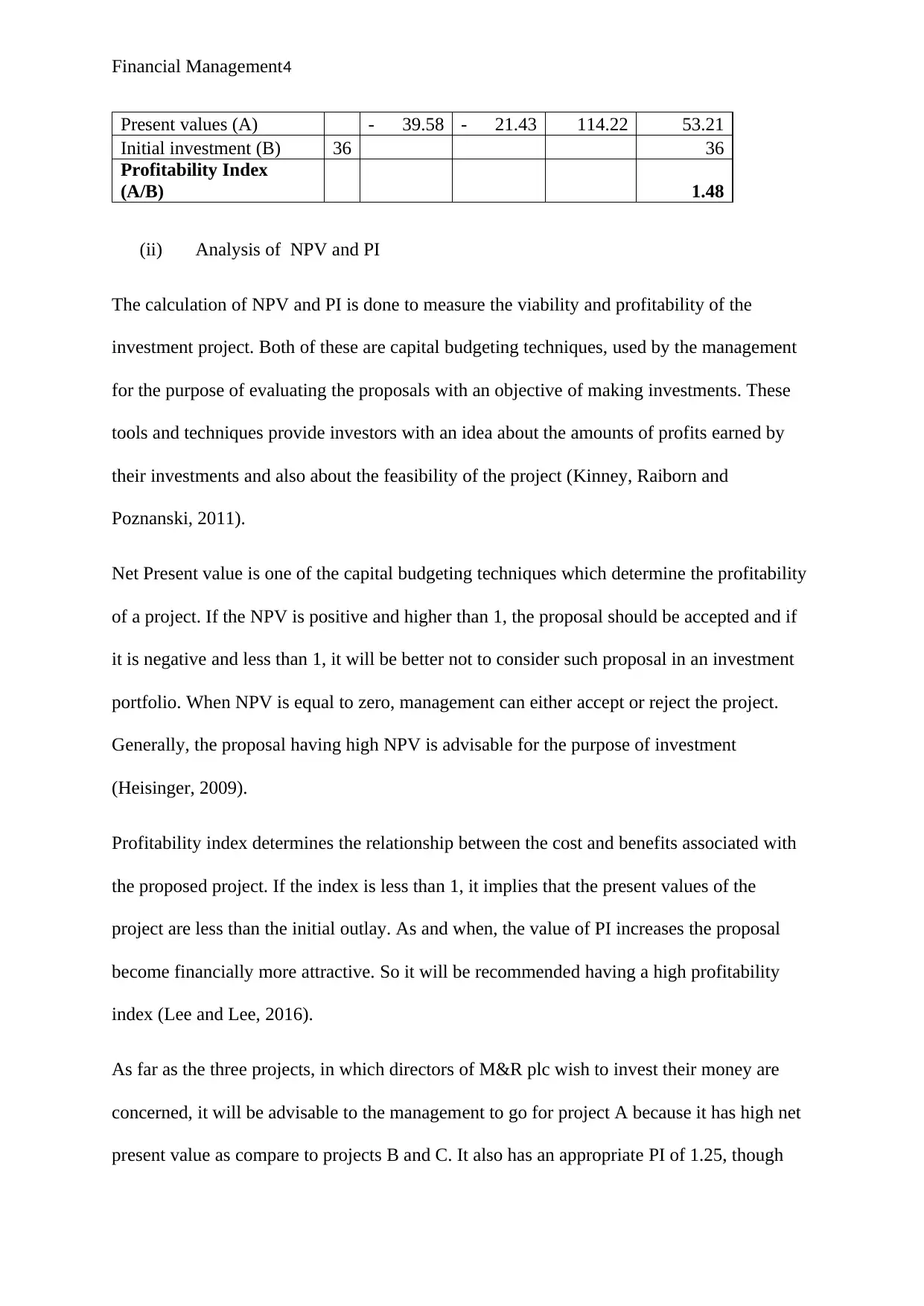
Financial Management4
Present values (A) - 39.58 - 21.43 114.22 53.21
Initial investment (B) 36 36
Profitability Index
(A/B) 1.48
(ii) Analysis of NPV and PI
The calculation of NPV and PI is done to measure the viability and profitability of the
investment project. Both of these are capital budgeting techniques, used by the management
for the purpose of evaluating the proposals with an objective of making investments. These
tools and techniques provide investors with an idea about the amounts of profits earned by
their investments and also about the feasibility of the project (Kinney, Raiborn and
Poznanski, 2011).
Net Present value is one of the capital budgeting techniques which determine the profitability
of a project. If the NPV is positive and higher than 1, the proposal should be accepted and if
it is negative and less than 1, it will be better not to consider such proposal in an investment
portfolio. When NPV is equal to zero, management can either accept or reject the project.
Generally, the proposal having high NPV is advisable for the purpose of investment
(Heisinger, 2009).
Profitability index determines the relationship between the cost and benefits associated with
the proposed project. If the index is less than 1, it implies that the present values of the
project are less than the initial outlay. As and when, the value of PI increases the proposal
become financially more attractive. So it will be recommended having a high profitability
index (Lee and Lee, 2016).
As far as the three projects, in which directors of M&R plc wish to invest their money are
concerned, it will be advisable to the management to go for project A because it has high net
present value as compare to projects B and C. It also has an appropriate PI of 1.25, though
Present values (A) - 39.58 - 21.43 114.22 53.21
Initial investment (B) 36 36
Profitability Index
(A/B) 1.48
(ii) Analysis of NPV and PI
The calculation of NPV and PI is done to measure the viability and profitability of the
investment project. Both of these are capital budgeting techniques, used by the management
for the purpose of evaluating the proposals with an objective of making investments. These
tools and techniques provide investors with an idea about the amounts of profits earned by
their investments and also about the feasibility of the project (Kinney, Raiborn and
Poznanski, 2011).
Net Present value is one of the capital budgeting techniques which determine the profitability
of a project. If the NPV is positive and higher than 1, the proposal should be accepted and if
it is negative and less than 1, it will be better not to consider such proposal in an investment
portfolio. When NPV is equal to zero, management can either accept or reject the project.
Generally, the proposal having high NPV is advisable for the purpose of investment
(Heisinger, 2009).
Profitability index determines the relationship between the cost and benefits associated with
the proposed project. If the index is less than 1, it implies that the present values of the
project are less than the initial outlay. As and when, the value of PI increases the proposal
become financially more attractive. So it will be recommended having a high profitability
index (Lee and Lee, 2016).
As far as the three projects, in which directors of M&R plc wish to invest their money are
concerned, it will be advisable to the management to go for project A because it has high net
present value as compare to projects B and C. It also has an appropriate PI of 1.25, though
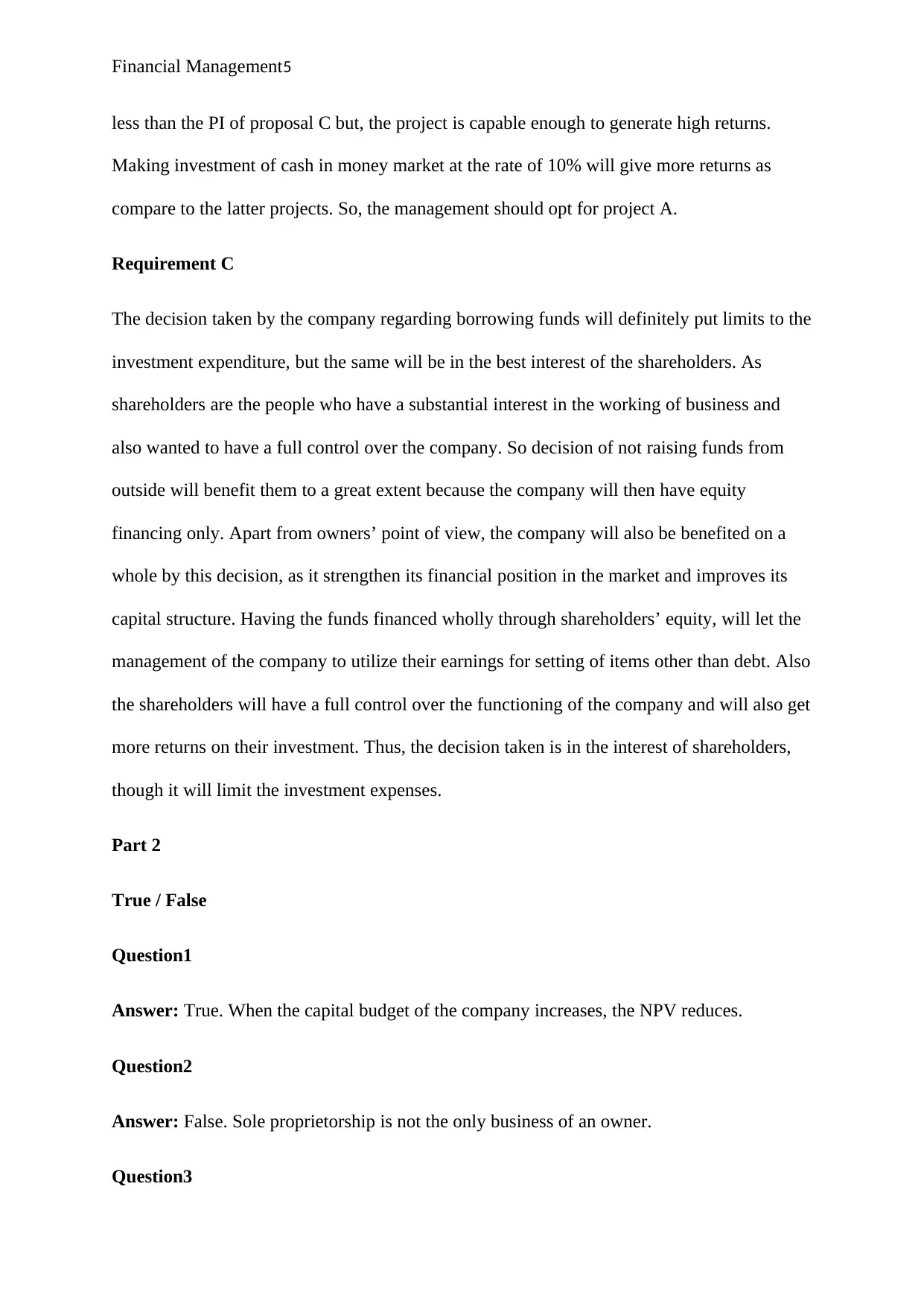
Financial Management5
less than the PI of proposal C but, the project is capable enough to generate high returns.
Making investment of cash in money market at the rate of 10% will give more returns as
compare to the latter projects. So, the management should opt for project A.
Requirement C
The decision taken by the company regarding borrowing funds will definitely put limits to the
investment expenditure, but the same will be in the best interest of the shareholders. As
shareholders are the people who have a substantial interest in the working of business and
also wanted to have a full control over the company. So decision of not raising funds from
outside will benefit them to a great extent because the company will then have equity
financing only. Apart from owners’ point of view, the company will also be benefited on a
whole by this decision, as it strengthen its financial position in the market and improves its
capital structure. Having the funds financed wholly through shareholders’ equity, will let the
management of the company to utilize their earnings for setting of items other than debt. Also
the shareholders will have a full control over the functioning of the company and will also get
more returns on their investment. Thus, the decision taken is in the interest of shareholders,
though it will limit the investment expenses.
Part 2
True / False
Question1
Answer: True. When the capital budget of the company increases, the NPV reduces.
Question2
Answer: False. Sole proprietorship is not the only business of an owner.
Question3
less than the PI of proposal C but, the project is capable enough to generate high returns.
Making investment of cash in money market at the rate of 10% will give more returns as
compare to the latter projects. So, the management should opt for project A.
Requirement C
The decision taken by the company regarding borrowing funds will definitely put limits to the
investment expenditure, but the same will be in the best interest of the shareholders. As
shareholders are the people who have a substantial interest in the working of business and
also wanted to have a full control over the company. So decision of not raising funds from
outside will benefit them to a great extent because the company will then have equity
financing only. Apart from owners’ point of view, the company will also be benefited on a
whole by this decision, as it strengthen its financial position in the market and improves its
capital structure. Having the funds financed wholly through shareholders’ equity, will let the
management of the company to utilize their earnings for setting of items other than debt. Also
the shareholders will have a full control over the functioning of the company and will also get
more returns on their investment. Thus, the decision taken is in the interest of shareholders,
though it will limit the investment expenses.
Part 2
True / False
Question1
Answer: True. When the capital budget of the company increases, the NPV reduces.
Question2
Answer: False. Sole proprietorship is not the only business of an owner.
Question3
⊘ This is a preview!⊘
Do you want full access?
Subscribe today to unlock all pages.

Trusted by 1+ million students worldwide
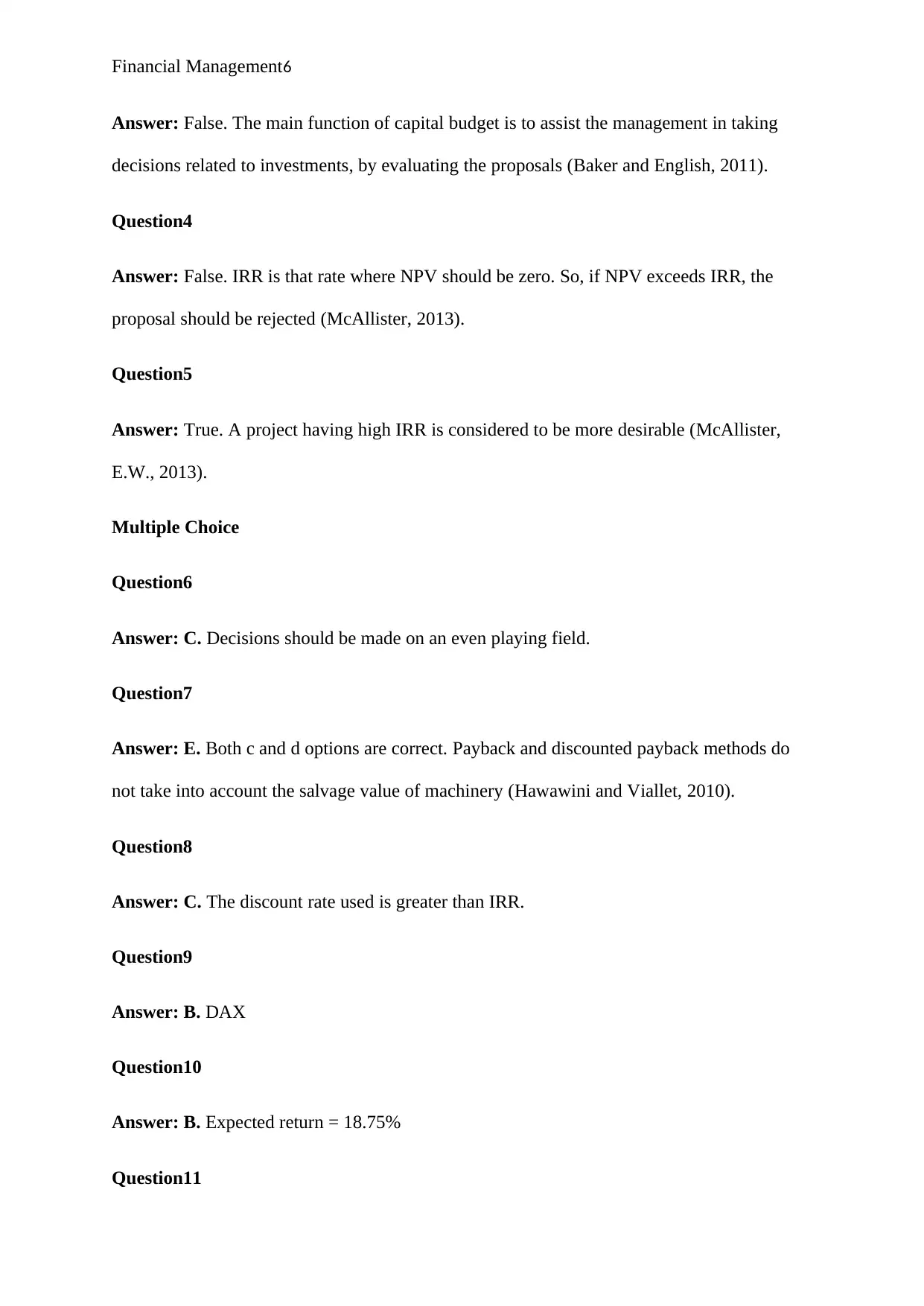
Financial Management6
Answer: False. The main function of capital budget is to assist the management in taking
decisions related to investments, by evaluating the proposals (Baker and English, 2011).
Question4
Answer: False. IRR is that rate where NPV should be zero. So, if NPV exceeds IRR, the
proposal should be rejected (McAllister, 2013).
Question5
Answer: True. A project having high IRR is considered to be more desirable (McAllister,
E.W., 2013).
Multiple Choice
Question6
Answer: C. Decisions should be made on an even playing field.
Question7
Answer: E. Both c and d options are correct. Payback and discounted payback methods do
not take into account the salvage value of machinery (Hawawini and Viallet, 2010).
Question8
Answer: C. The discount rate used is greater than IRR.
Question9
Answer: B. DAX
Question10
Answer: B. Expected return = 18.75%
Question11
Answer: False. The main function of capital budget is to assist the management in taking
decisions related to investments, by evaluating the proposals (Baker and English, 2011).
Question4
Answer: False. IRR is that rate where NPV should be zero. So, if NPV exceeds IRR, the
proposal should be rejected (McAllister, 2013).
Question5
Answer: True. A project having high IRR is considered to be more desirable (McAllister,
E.W., 2013).
Multiple Choice
Question6
Answer: C. Decisions should be made on an even playing field.
Question7
Answer: E. Both c and d options are correct. Payback and discounted payback methods do
not take into account the salvage value of machinery (Hawawini and Viallet, 2010).
Question8
Answer: C. The discount rate used is greater than IRR.
Question9
Answer: B. DAX
Question10
Answer: B. Expected return = 18.75%
Question11
Paraphrase This Document
Need a fresh take? Get an instant paraphrase of this document with our AI Paraphraser
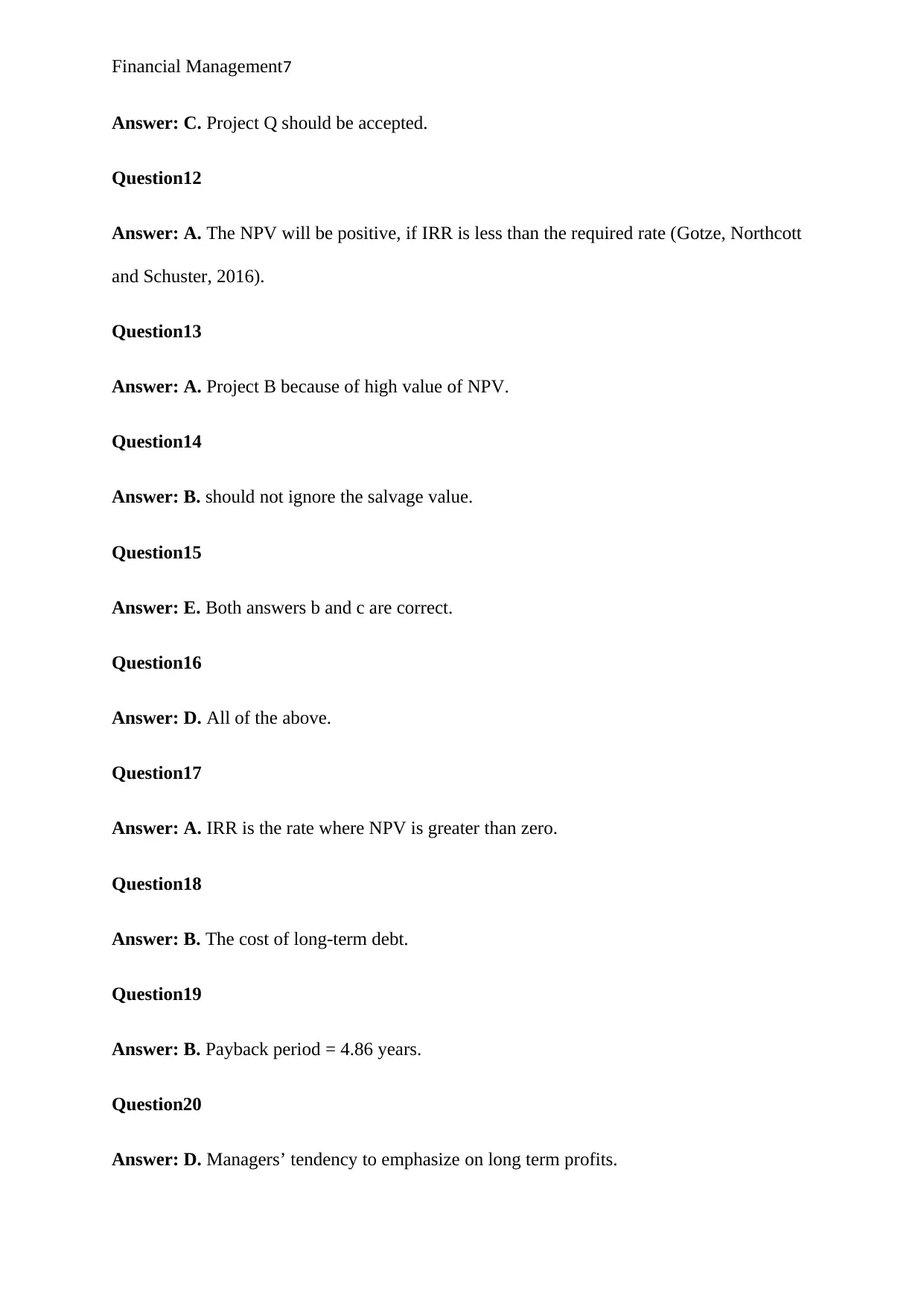
Financial Management7
Answer: C. Project Q should be accepted.
Question12
Answer: A. The NPV will be positive, if IRR is less than the required rate (Gotze, Northcott
and Schuster, 2016).
Question13
Answer: A. Project B because of high value of NPV.
Question14
Answer: B. should not ignore the salvage value.
Question15
Answer: E. Both answers b and c are correct.
Question16
Answer: D. All of the above.
Question17
Answer: A. IRR is the rate where NPV is greater than zero.
Question18
Answer: B. The cost of long-term debt.
Question19
Answer: B. Payback period = 4.86 years.
Question20
Answer: D. Managers’ tendency to emphasize on long term profits.
Answer: C. Project Q should be accepted.
Question12
Answer: A. The NPV will be positive, if IRR is less than the required rate (Gotze, Northcott
and Schuster, 2016).
Question13
Answer: A. Project B because of high value of NPV.
Question14
Answer: B. should not ignore the salvage value.
Question15
Answer: E. Both answers b and c are correct.
Question16
Answer: D. All of the above.
Question17
Answer: A. IRR is the rate where NPV is greater than zero.
Question18
Answer: B. The cost of long-term debt.
Question19
Answer: B. Payback period = 4.86 years.
Question20
Answer: D. Managers’ tendency to emphasize on long term profits.
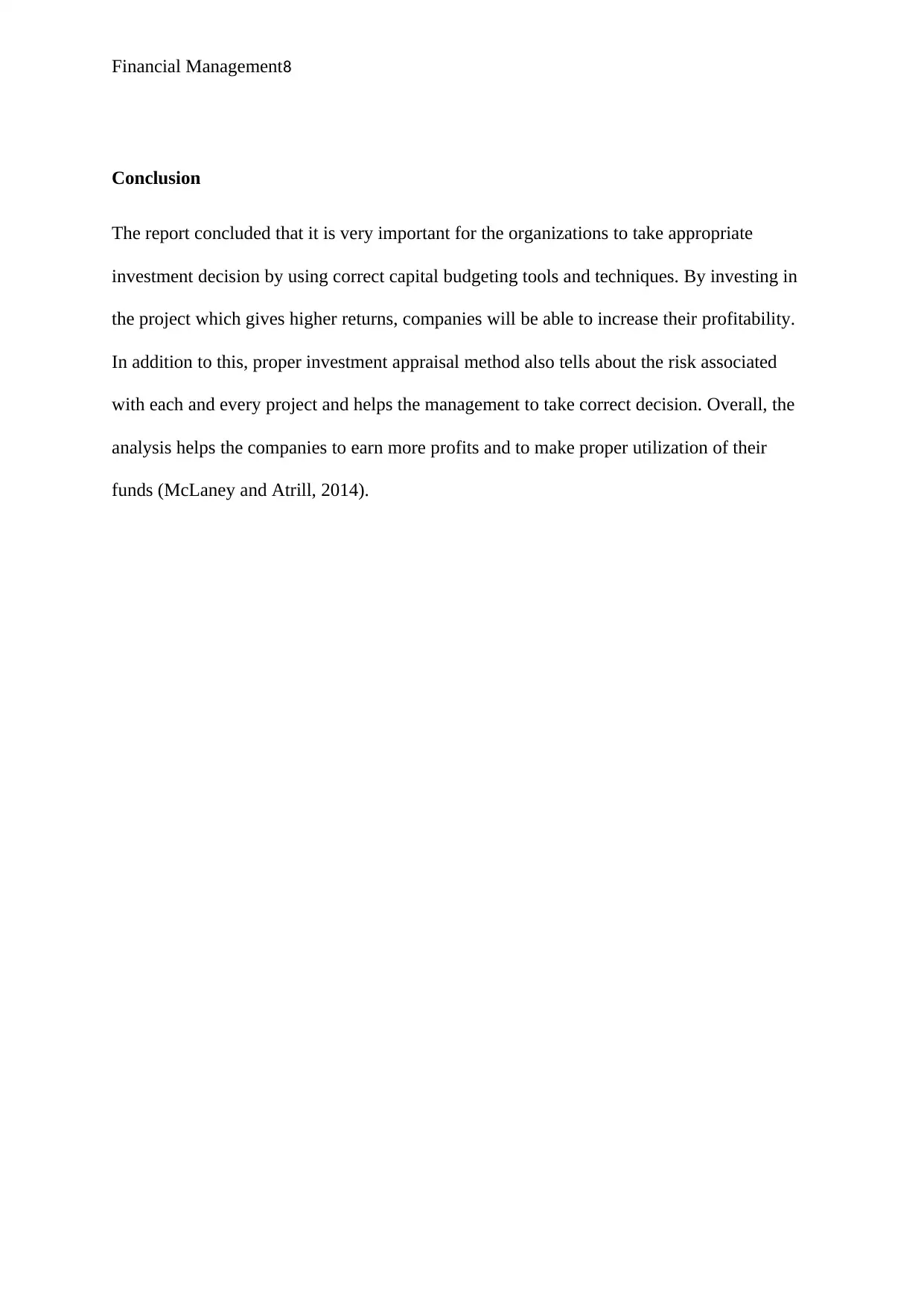
Financial Management8
Conclusion
The report concluded that it is very important for the organizations to take appropriate
investment decision by using correct capital budgeting tools and techniques. By investing in
the project which gives higher returns, companies will be able to increase their profitability.
In addition to this, proper investment appraisal method also tells about the risk associated
with each and every project and helps the management to take correct decision. Overall, the
analysis helps the companies to earn more profits and to make proper utilization of their
funds (McLaney and Atrill, 2014).
Conclusion
The report concluded that it is very important for the organizations to take appropriate
investment decision by using correct capital budgeting tools and techniques. By investing in
the project which gives higher returns, companies will be able to increase their profitability.
In addition to this, proper investment appraisal method also tells about the risk associated
with each and every project and helps the management to take correct decision. Overall, the
analysis helps the companies to earn more profits and to make proper utilization of their
funds (McLaney and Atrill, 2014).
⊘ This is a preview!⊘
Do you want full access?
Subscribe today to unlock all pages.

Trusted by 1+ million students worldwide
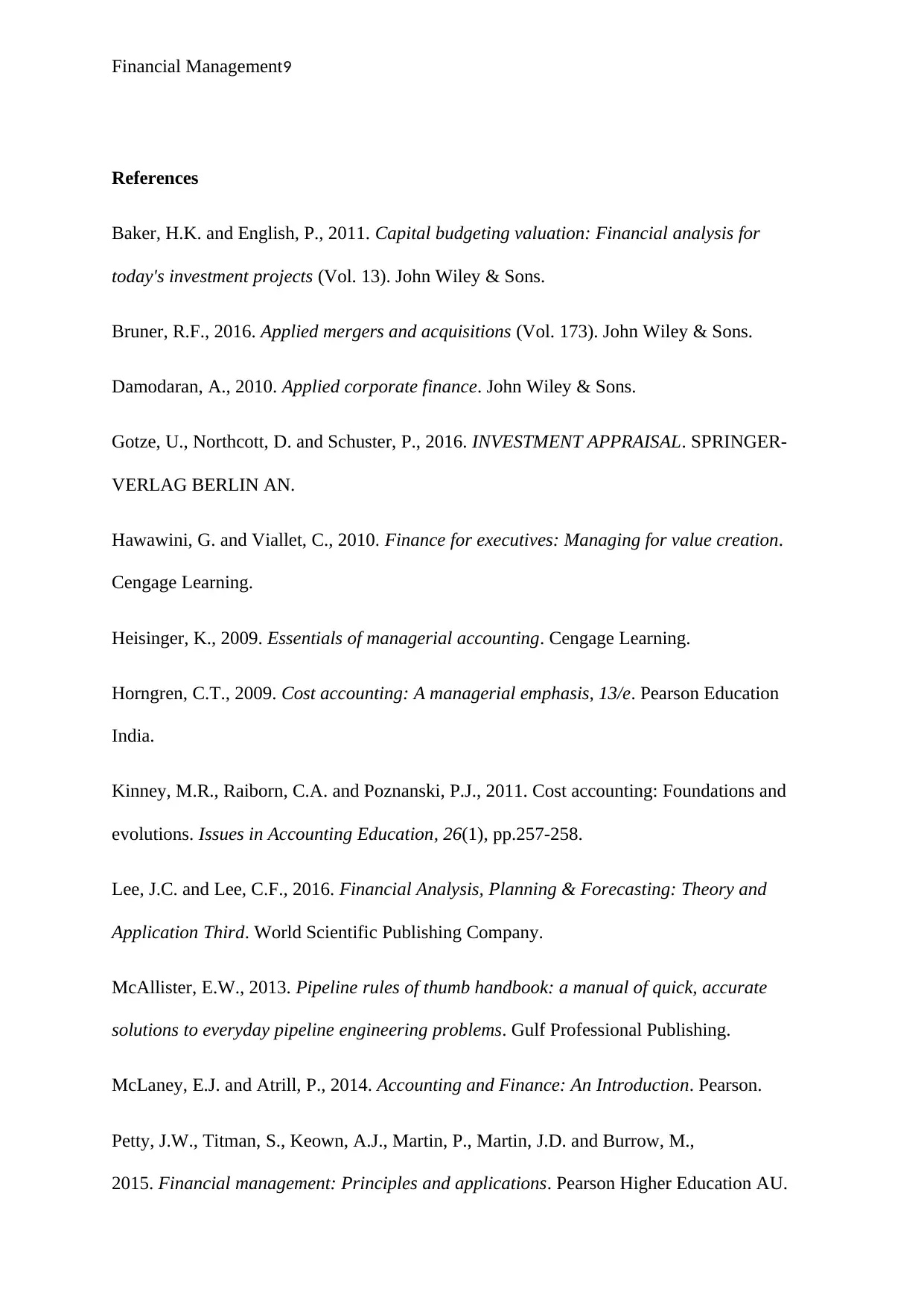
Financial Management9
References
Baker, H.K. and English, P., 2011. Capital budgeting valuation: Financial analysis for
today's investment projects (Vol. 13). John Wiley & Sons.
Bruner, R.F., 2016. Applied mergers and acquisitions (Vol. 173). John Wiley & Sons.
Damodaran, A., 2010. Applied corporate finance. John Wiley & Sons.
Gotze, U., Northcott, D. and Schuster, P., 2016. INVESTMENT APPRAISAL. SPRINGER-
VERLAG BERLIN AN.
Hawawini, G. and Viallet, C., 2010. Finance for executives: Managing for value creation.
Cengage Learning.
Heisinger, K., 2009. Essentials of managerial accounting. Cengage Learning.
Horngren, C.T., 2009. Cost accounting: A managerial emphasis, 13/e. Pearson Education
India.
Kinney, M.R., Raiborn, C.A. and Poznanski, P.J., 2011. Cost accounting: Foundations and
evolutions. Issues in Accounting Education, 26(1), pp.257-258.
Lee, J.C. and Lee, C.F., 2016. Financial Analysis, Planning & Forecasting: Theory and
Application Third. World Scientific Publishing Company.
McAllister, E.W., 2013. Pipeline rules of thumb handbook: a manual of quick, accurate
solutions to everyday pipeline engineering problems. Gulf Professional Publishing.
McLaney, E.J. and Atrill, P., 2014. Accounting and Finance: An Introduction. Pearson.
Petty, J.W., Titman, S., Keown, A.J., Martin, P., Martin, J.D. and Burrow, M.,
2015. Financial management: Principles and applications. Pearson Higher Education AU.
References
Baker, H.K. and English, P., 2011. Capital budgeting valuation: Financial analysis for
today's investment projects (Vol. 13). John Wiley & Sons.
Bruner, R.F., 2016. Applied mergers and acquisitions (Vol. 173). John Wiley & Sons.
Damodaran, A., 2010. Applied corporate finance. John Wiley & Sons.
Gotze, U., Northcott, D. and Schuster, P., 2016. INVESTMENT APPRAISAL. SPRINGER-
VERLAG BERLIN AN.
Hawawini, G. and Viallet, C., 2010. Finance for executives: Managing for value creation.
Cengage Learning.
Heisinger, K., 2009. Essentials of managerial accounting. Cengage Learning.
Horngren, C.T., 2009. Cost accounting: A managerial emphasis, 13/e. Pearson Education
India.
Kinney, M.R., Raiborn, C.A. and Poznanski, P.J., 2011. Cost accounting: Foundations and
evolutions. Issues in Accounting Education, 26(1), pp.257-258.
Lee, J.C. and Lee, C.F., 2016. Financial Analysis, Planning & Forecasting: Theory and
Application Third. World Scientific Publishing Company.
McAllister, E.W., 2013. Pipeline rules of thumb handbook: a manual of quick, accurate
solutions to everyday pipeline engineering problems. Gulf Professional Publishing.
McLaney, E.J. and Atrill, P., 2014. Accounting and Finance: An Introduction. Pearson.
Petty, J.W., Titman, S., Keown, A.J., Martin, P., Martin, J.D. and Burrow, M.,
2015. Financial management: Principles and applications. Pearson Higher Education AU.
Paraphrase This Document
Need a fresh take? Get an instant paraphrase of this document with our AI Paraphraser

Financial Management10
Parrino, R., Kidwell, D.S. and Bates, T., 2011. Fundamentals of corporate finance. John
Wiley & Sons.
Parrino, R., Kidwell, D.S. and Bates, T., 2011. Fundamentals of corporate finance. John
Wiley & Sons.
1 out of 11
Related Documents
Your All-in-One AI-Powered Toolkit for Academic Success.
+13062052269
info@desklib.com
Available 24*7 on WhatsApp / Email
![[object Object]](/_next/static/media/star-bottom.7253800d.svg)
Unlock your academic potential
Copyright © 2020–2025 A2Z Services. All Rights Reserved. Developed and managed by ZUCOL.





